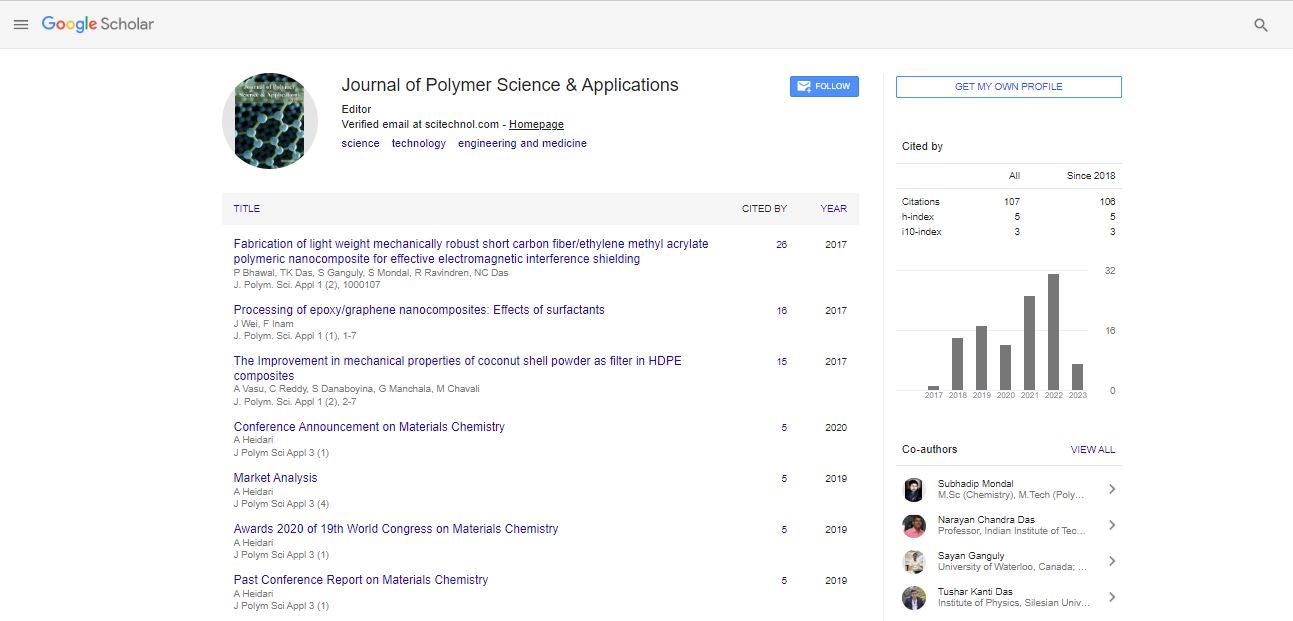Opinion Article, J Polym Sci Appl Vol: 7 Issue: 1
Assembling Interaction for Delivering Parts by Infusing Liquid material
Alok Lin*
Department of Composite Engineering, Technical University of Kaiserslautern, Kaiserslautern, Germany
*Corresponding Author: Alok Lin
Department of Composite Engineering, Technical University of Kaiserslautern, Kaiserslautern, Germany
E-mail: alok@yahoo.com
Received date: 18 February, 2023, Manuscript No. JPSA-22-64403;
Editor assigned date: 20 February, 2023, PreQC No. JPSA-22-64403 (PQ);
Reviewed date: 06 March, 2023, QC No. JPSA-22-64403;
Revised date: 13 March, 2023, Manuscript No. JPSA-22-64403 (R);
Published date: 20 March, 2023, DOI: 10.4172/Jpsa.1000131
Citation: Lin A (2023) Assembling Interaction for Delivering Parts by Infusing Liquid material. J Polym Sci Appl 7:1.
Description
Injection moulding is an assembling interaction for delivering parts by infusing liquid material into a form or shape. Infusion embellishment can be performed with a large group of materials essentially including metals for which the interaction is called bite the dust projecting, glasses, elastomers, desserts, and most normally thermoplastic and thermosetting polymers. Material for the part is taken care of into a warmed barrel, blended utilizing a helical screw, and infused into a shape cavity, where it cools and solidifies to the setup of the hole. After an item is planned, as a rule by a modern creator or a specialist, molds are made by a shape producer from metal, generally either steel or aluminum, and accuracy machined to frame the elements of the ideal part. Injection moulding is generally utilized for assembling an assortment of parts, from the littlest parts to whole body boards of vehicles.
Infusion forming utilizes a unique reason machine that has three sections the infusion unit, the shape and the clasp. Parts to be infusion formed should be painstakingly intended to work with the embellishment interaction; the material utilized for the part, the ideal shape and highlights of the part, the material of the form, and the properties of the trim machine should be generally considered. The flexibility of infusion forming is worked with by this broadness of plan contemplations and potential outcomes. Infusion forming is utilized to make numerous things, for example, wire spools, bundling, bottle covers, auto parts and parts, toys, pocket brushes, a few instruments and portions of them, one-piece seats and little tables, stockpiling compartments, mechanical parts counting gears, and most other plastic items accessible today. Injection moulding is the most widely recognized current strategy for assembling plastic parts; it is great for creating high volumes of a similar item. Infusion forming utilizes a smash or screw-type unclogged to compel liquid plastic or elastic material into a form hole; this cements into a shape that has adjusted to the form of the shape. It is most generally used to handle both thermoplastic and thermosetting polymers, with the volume utilized of the previous being impressively higher. Thermoplastics are pervasive because of qualities that make them exceptionally reasonable for infusion forming, like simplicity of reusing, flexibility for a wide assortment of uses, and capacity to relax and stream on warming.
Thermoplastics likewise have a component of wellbeing over thermosets; in the event that a thermosetting polymer isn't launched out from the infusion barrel on time, compound crosslinking may happen making the screw and check valves seize and possibly harming the infusion forming machine.
Injection moulding comprises of the great strain infusion of the natural substance into a form, which shapes the polymer into the ideal structure. Molds can be of a solitary pit or various depressions. In various cavity shapes, every cavity can be indistinguishable and structure similar parts or can be extraordinary and structure numerous various calculations during a solitary cycle. Molds are for the most part produced using instrument prepares, however hardened steels and aluminium molds are appropriate for specific applications. Aluminium molds are normally inappropriate for high volume creation or parts with limited layered resilience’s, as they have second rate mechanical properties and are more inclined to wear, harm, and distortion during the infusion and bracing cycles; in any case, aluminium molds are savvy in low-volume applications, as shape manufacture expenses and time are significantly reduced. Many steel molds are intended to handle above and beyond 1,000,000 sections during their lifetime and can cost a huge number of dollars to manufacture.
Whenever thermoplastics are shaped, regularly pelletized unrefined substance is taken care of through a container into a warmed barrel with a responding screw. This interaction decreases its consistency, which empowers the polymer to stream with the main impetus of the infusion unit. The screw conveys the natural substance forward, blends and homogenizes the warm and gooey circulations of the polymer, and decreases the necessary warming time by precisely shearing the material and adding a lot of frictional warming to the polymer. The material feeds forward through a check valve and gathers at the front of the screw into a volume known as a shot. A shot is the volume of material that is utilized to fill the form pit, make up for shrinkage, and give around 10% of the all-out shot volume, which stays in the barrel and keeps the screw from reaching as far down as possible to move strain from the screw to the shape depression. At the point when enough material has assembled, the material is constrained at high tension and speed into the part framing depression. The specific measure of shrinkage is an element of the gum being utilized, and can be somewhat predictable. To forestall spikes in pressure, the interaction ordinarily utilizes an exchange position relating to a 95%-98% full cavity where the screw shifts from a consistent speed to a steady strain control.
 Spanish
Spanish  Chinese
Chinese  Russian
Russian  German
German  French
French  Japanese
Japanese  Portuguese
Portuguese  Hindi
Hindi 